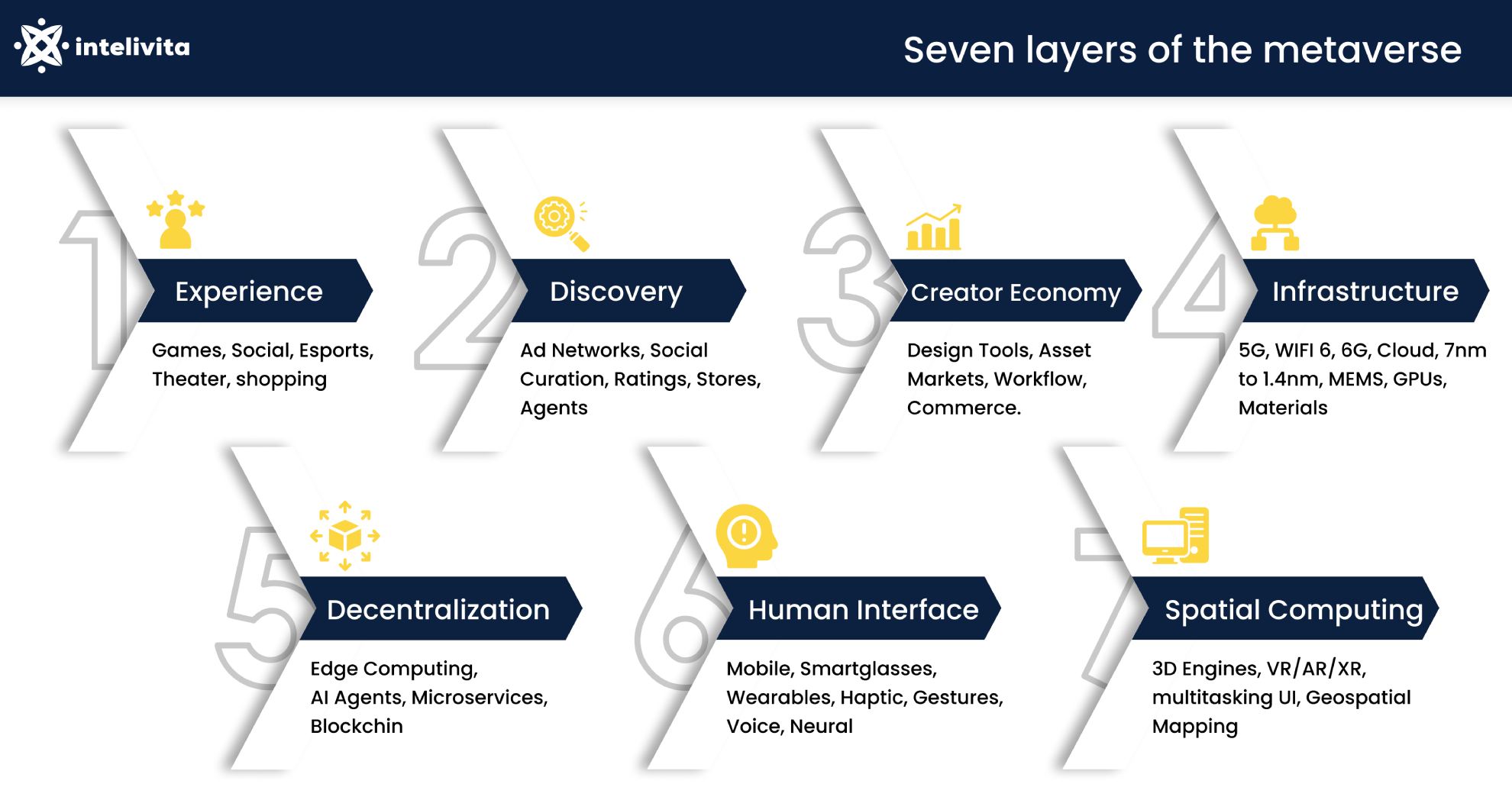Metaverse is now a regular buzzword.
People are using it left and right, for the right reasons and the wrong ones.
Despite where each of us align ourselves, the metaverse inevitably has made its mark in the tech world.
Before we move on to questions like how to create a metaverse, it is helpful to start with the basic question, what is a metaverse and build from there on.
So, get ready for an informative read as we intend to share everything you need to know about metaverse and how to develop one.
What is a Metaverse?
A metaverse is a virtual environment, where virtual replicas of real-life people interact and connect.
They do things in the virtual world, as they do in the real world, with their virtual form called ‘avatars’.
It is a kind of a parallel world. Just like the ‘Upside Down’ in Stranger Things.
Now, technically speaking, metaverse is a virtual space created by the convergence of many different technologies.
It requires Virtual Reality (VR), Augmented Reality (AR), HMDs, IoTs, spatial computing, Artificial Intelligence, etc.
Metaverse is still on a developing stage and companies are investing massively to make this a viable commercial and social space.
Our metaverse development services can help you create an innovative and engaging platform for your audience.
Connect with our team of experts to get the exact cost estimation for your metaverse solution today!
Characteristics of Metaverse
When you create your own metaverse, you have total control to decide and implement what you want.
Because it is a digital space with digital characters.
However, if this freedom is not total then the metaverse will lose its appeal.
So when you create a metaverse application, openness should be at the heart of it.
And in order to ensure transparency during metaverse app development the following six characteristics are essential:
- Interoperability: The effortless portability of a user’s data and digital assets without the limits of platforms and applications.
- Decentralization: Users should have full control of the data and their assets.
- Persistent: Metaverse should have persistent elements.
It should exist around your digital space, just like the natural resources around you.
- Spatial: Digital assets should be findable and easily searchable.
- Community factor: Metaverse should be community driven and the involved brands should acknowledge the community factor in the metaverse.
- Individuality: A user is a digital individual in a metaverse.
Hence, all the natural laws of individuality like privacy, personal and private protection should be applicable.
How Does The Metaverse Work in Practice?
Just like real life, the metaverse has many layers.
Understanding these layers is important to get a practical idea about how metaverse works.
So far we have seen the metaverse as a parallel world.
Now, let us see it through the many traits it exhibits.
These traits will show you how to build apps for the metaverse in the existing social and technological context.
Experiences
It is the gateway to every virtual application.
The three-dimensional or two-dimensional forms define the kind of experience a user derives from the metaverse.
It can be defined in simple terms as the activity a user can take part in the metaverse.
For example, it could be a car race, a shopping experience, online gaming, or any other kind of social interaction.
Discovery
We as humans love to discover things.
Because there is nothing like the discovery that gives joy.
So when you are building a metaverse application you need to deliver constant bouts of discovery for users.
An example is an in-app map of a treasure.
A family legacy you uncovered or people finding booths, etc.
The discovery part of the metaverse can incorporate the social element to make it more engaging for users.
Creator economy
The creator economy refers to that rising group of creators like developers, content creators, designers, etc.
The main feature of the creator economy is that it has many tools and platforms for creating metaverse spaces.
And these tools do not require any programming experience.
Spatial computing
Spatial computing involves blurring the line between the real and virtual in the digital space.
Virtual Reality (VR) and AR (Augmented Reality) experiences can combine to make this possible.
Spatial computing will enable users to have more control over 3D places and explore digital objects
Decentralization
The metaverse works in a decentralized, open, distributed environment. The Decentralized Autonomous Organization (DAO) with open ownership is at the very center of it.
Blockchain is a solution to the centralization tendency of the metaverse.
Already many virtual projects are leveraging the power of blockchain. Decentraland is a perfect example of this scenario. It runs on the Ethereum blockchain.
Human interface
The human interface is where a user explores the metaverse.
The human-computer interaction includes VR headsets, haptic technologies, smart glasses, etc.
Infrastructure
It is the base for all the above layers.
5G network capability for better network capacity, latency, and reduced congestion.
The human-machine interface devices need to be built from MEMS, tiny, long-lasting batteries.
Wi-Fi, Blockchain, Artificial Intelligence (AI), GPUs, cloud architecture, etc. forms the other essential infrastructure.
How To Create A Metaverse?
Yes, the most gripping question. We come to it finally. Where to begin our journey?
The first step is choosing a proper use case for the metaverse.
The idea and how to perceive it digitally are very important.
So when you create your own metaverse, start from the idea.
The next step in metaverse app development is the creation of a user interface.
Depending on the idea you have, plan out a user interface that is engaging and immersive.
After selecting a user interface code the operational smart contracts. It can be done using the if/then statements combined with blockchain technology.
The conditions you want the user to meet, the resultant workflow, and the consequent action all need to be pre-planned in detail.
Then, it is time to bring in the IPFS (Interplanetary Filing System).
IPFS creates that decentralization of content, and hence the data is stored in thousands of peers instead of a central server.
You will have to move away from the traditional storage servers when you create a metaverse application.
As every piece of data is hashed cryptographically it can prevent censorship and monopoly.
Also, it is a safe backup. Because even if your personal IPFS node is down it can load from other nodes across the globe.
After that, create a metaverse database. And then start working on the core AI and VR functionalities.
It will play a key role in developing the metaverse, as you imagined it.
Integrate the smart contracts and global server with your application’s front and back end.
The next process in building a metaverse application is common to all app developments i.e testing.
Test your app for bugs and glitches.
Ensure its security and quality during this phase. And once you are satisfied, release a beta version to test the waters.
The Beta version will give you a lot of valuable information like user experience, acceptance, market scope, etc.
Once you modify your application accordingly. It is time to deploy the final metaverse platform.
What is The Difference Between Metaverse And Multiverse?
The basic difference between a metaverse and a multiverse is that:
A metaverse is a shared environment where shared activities like working, watching movies, playing sports, games, etc. are possible.
On the other hand, the multiverse is an imaginary collection of virtual words with varying traits and features.
In a metaverse, there is only one shared universe where a user moves freely between different platforms.
However, in a multiverse, a user is within a hypothetical pool of virtual words with many ecosystems.
Another distinguishing feature of a metaverse is the specific order of the flow of information.
In a multiverse, no such specificity exists.
It has a random flow of information through multiple universes.
One of the key benefits of metaverse over a multiverse is that in a metaverse digital assets and experiences can be owned by a user.
Multiverse has no such advantage as users cannot own assets in separate virtual worlds.
Further, the metaverse includes AI, robots, and avatars (digital and human). But multiverses are made of virtual worlds alone.
That sums up the key differences between a multiverse and a metaverse.
Technologies Used to Create a Metaverse
The key technologies that power the metaverse are:
Artificial intelligence
AI with its potential to process data at a high speed is crucial to the development of applications of the metaverse.
It combines machine learning techniques and AI algorithms to create a virtual universe that is exemplary.
Blockchain
The role of blockchain technology in building a metaverse application is unrivaled.
The key traits of the metaverse like decentralization, transparency, digital ownership, its proof, governance, transfer of value, interoperability, accessibility, etc. depend on it.
Augmented reality(AR) and Virtual reality(VR)
Being the entry points into any metaverse application they help in crafting immersive and engaging digital experiences.
AR applications help in providing accessible and real visual elements and characters.
While VR provides that total virtual ecosystem for the user to explore with VR glasses, gloves, sensors, etc.
3D reconstruction
One of the key questions that the developers couldn’t answer was: ‘How to develop a metaverse that is close to real experience?’ The answer to this came in the form of 3D reconstruction.
With this technology, you can create realistic and natural-looking spaces. Special 3D cameras allow you to take the world around you online. It helps in creating the digital twin of our real world.
What are The Security Concerns of the Metaverse?
When you create the metaverse, you are creating a world just like the real ones, with all its imperfections and challenges.
So, now it’s time to look at the key security concerns of the metaverse.
- Moderation challenges – In a metaverse, there is no support access. It can leave the users stranded in a wide digital world.
- NFTs – NFTs in a way regulate the ownership of digital assets yet they cannot provide storage for them. Hence, it opens the possibility of ransom attacks. Ransomware can encrypt NFT files and make them inaccessible for users without changing their ownership over them.
- Darkverse – Just like the dark web, darkverse, exists inside the metaverse. The pseudo-physical presence of users makes it more formidable and dangerous. Identity thefts and spoofing in the darkverse is also a real threat.
- Financial fraud – Metaverse will be driving a huge volume of e-commerce and hence the risk of financial fraud. People with criminal tendencies are likely to be drawn toward them.
- Privacy issues – NFTs in a way regulate the ownership of digital assets yet they cannot provide storage for them. Hence, it opens the possibility of ransom attacks. Ransomware can encrypt NFT files and make them inaccessible for users without changing their ownership over them.
- Social engineering – It involves the psychological manipulation of users to trick them into giving sensitive data. And then with this sensitive information, the hackers can make access into users’ private information, passwords, etc.
- Cyber-physical threats – Spatial Web which is a 3D-based computing environment where billions of connected devices create VR/AR/MR/XR interfaces. Since it will be an interactive domain, metaverse applications will be susceptible to cyber-physical attacks.
Standards and Requirements for Developing Metaverse
The Internet works on standards and protocols for communication, data, graphics, and presentation.
So when you create a metaverse application you will need a more complex set of standards.
Because a metaverse involves wide-scale interoperable and live synchronous experiences.
The standards and protocol requirements will have to be such that it follows the principle of decentralization.
Higher bandwidth is an essential requirement to prevent monopoly.
Open and interoperable standards are needed for media like audio, video, 3D scenes, applications with vectors, text, images, etc.
Open programming languages like HTML, JavaScript, WebAssembly, WebXR, etc. are also very essential for eXtended Reality (XR) to combine the real and virtual ecosystems and to make human-machine interactions smoother. In addition to it, we have previously seen the role of blockchain technology, AI, and IoTs in developing the metaverse.
Metaverse for Various Industries
About 95% of business magnates are expecting the metaverse to transform their business positively. McKinsey & Company in their report shows how the companies perceive their role in developing the metaverse.
The companies are planning to support the metaverse by offering hardware and applications.
And extract benefits by collecting fresh customer data.
Many companies are already developing virtual products exclusively for the metaverse. Products that will enhance customer experience.
Now, let us see what metaverse means for various industries:
Automobile
The metaverse can transform the way automobile dealership operates.
With digital showrooms and virtual test drives, the showroom experience is going to change drastically.
Customers can pick the look and feel of their favorite vehicles, the interior and front-view and long-drive experiences, etc.
Healthcare
The Healthcare industry will undergo a paradigm shift with the metaverse. A new techno-medical concept called meta-medicine will integrate user data and technology in medicine.
It will enhance the medical Internet of Things powered by AR and VR glasses.
Haptic sensors combined with AR and VR technologies will improve the way cognitive therapy, support groups, psychiatric evaluations, rehabilitation, etc. are delivered to patients.
Diagnosis and medical procedures will be robotically handled.
The takeaway of the metaverse in healthcare is that it will outdo the cost to build metaverse.
Manufacturing
In the manufacturing industry, the metaverse will reshape design, training, production, decision-making, and onboarding processes.
BMW has set an example of the power of AIs in managing assembly lines. The company runs a full production cycle through virtual simulation.
The 3D prototype rendering and simulations will be a game changer in this industry.
Gaming
Video gaming will never be the same. 3D avatars, virtual worlds, and immersive-interactive games have already brought epic changes.
In the gaming industry, the cost to build a metaverse is nothing compared to the revenue it generates.
In 2020, gaming outdid both movies and sports combined. Epic game’s 1 billion dollar investment and the growing users of Roblox games are all proof of what metaverse can do to the gaming industry.
How Much Does It Cost to Create a Metaverse Platform
The cost to build a metaverse is the next question that one asks after understanding its possibilities.
Since it involves a fusion of technologies like blockchain, IoT, AR, VR, AI, machine learning, etc. the cost naturally goes up.
Despite many different technologies, you can significantly cut the cost to build a metaverse.
And that can be realized by taking care of the following things:
- Infrastructure – An accurate estimate of the infrastructure you need in developing the metaverse can go a long way.
For example, an accurate number of VR glasses, headsets, smartphones, PCs, 5G networks you need can help you cut the cost of development.
- Digital avatars – The digital replica of real individuals, the avatars need some intensive work. Understanding the user’s need, i.e whether they want to load a predesigned avatar or create an exact copy of themselves can affect the budget significantly.
The more subtle the avatar’s ability to handle emotions and feelings, the more will be the work on developers, hence the cost.
- Security – another area where the cost to build metaverse can shoot up is security.
Layering your metaverse application in security nets will add to the overall production cost.
Now the cost of a metaverse application depends also on the type of application.
For example, a gaming platform can take $30,000 to $300,000 or more.
While a social media application can range from $25,000 to $400,000.
And, a real estate application can be produced with a budget of around $15,000 to $300,000.
Here the upper-end costs are nearly equal. It is because to create a metaverse application with full capability more resources are needed.
Things to Consider Before Building a Metaverse Project
A good business is always a balance of opportunities and what you have.
So before you start on your metaverse project keep the following things in mind, so that your project does not backfire on your business:
-
Business goals over metaverse
Never impose metaverse over your business goals. If you want to reap the benefits of metaverse, always remember one thing i.e metaverse is a tool in your custom strategy.
If building a metaverse application can enhance your customer strategy, then just go for it.
Just don’t compromise your business goals for the metaverse.
-
Be people-centric
When you create a metaverse application always remember to put people at the center of the design.
You are creating solutions for people based on how people think, interact and perceive the problem.
Technology is just a means to deliver it to them.
-
Plan your resources
Like every project, the development of applications for metaverse needs foresight.
You need to plan your resource pool, the technologies you lack, and how you plan to procure them.
You may need to decide on housing a developing team or hiring one temporarily.
You may need to develop an exclusive solution or buy existing solutions.
-
Understand the vendor sentiments
Business leads should keep a check on the present vendor sentiment towards the metaverse.
For example, Microsoft recently announced that it will pair Mesh with Teams for VR collaborations.
So as Microsoft brings this metaverse element to you, you need to work with users to provide maximum extension and benefit to them.
So when you create your own metaverse meditate on these aspects regularly.
Top Companies Building the Metaverse
Companies are showing a mixed approach towards metaverse in the public.
Some tech giants are skeptical about the metaverse and consider it science fiction.
Some are concerned about individual privacy and security.
Whatever their outward talk on metaverse, the following companies are working with the metaverse in earnest:
The top tech giant would never leave any stone unturned in the tech world. Metaverse is no exception to Google.
Google perceives the metaverse as evolving computing in an immersive way.
With over $39.5 million as a private equity fund for metaverse projects, Google is working with Augmented Reality (AR) software and hardware.
Recently, Google acquired Alter, a digital avatar startup.
So things are indeed going strong in the metaverse lab of Google, behind the screen.
Meta
Well if you have been on techno camping, Meta is the new name for Facebook.
And the name change is an indicator of how Mark Zuckerberg views the metaverse.
They’re damn serious about it.
Meta has recently announced that creators on Instagram will be soon able to make their own collectibles and sell them to fans in and outside of Instagram.
Meta is at the top of the list of companies that are intensively working on how to develop the metaverse on a large scale.
Binance
Binance is today the world’s leading ecosystem of blockchain technology.
Since NFTs are central to the metaverse in determining identity, providing community and social experiences.
Metaverse tokens from Binance NFT Marketplace can be used to purchase in-world products and services.
Microsoft
How can Microsoft fall behind in any tech race? Yes, Microsoft is all into metaverse and the recent tie-up with Meta to enhance metaverse hardware integration is a significant move.
The partnership is bringing Office 365 apps into the metaverse.
Microsoft is scaling-up its metaverse investments over the last few years and are a force to reckon with in the metaverse app development.
Other companies like Decentraland, The Sandbox, Nvidia, etc. releasing new products that will form an important part of the metaverse in the future.
Maticz is another company in the metaverse industry focusing on building houses.
Besides these names, a lot of startups are in the metaverse development industry as well.
Conclusion
As more and more users switch toward VR and AR-based apps, businesses are trying to build brand value through metaverse applications.
So, creating a metaverse application is now the top priority for many enterprises.
When you start developing the metaverse take a holistic view of your business, clients, and resources.
Every industry has its niche and it is essential to see that the metaverse fits with it.
At Intelivita, we have already made the move towards the future with our augmented reality app development services.
We have industry-wide exposure in AR app development and have built apps across verticals like real estate, healthcare, education, gaming, and travel, to name a few.
If you are looking to step onto the Metaverse bandwagon, we are the perfect people to partner with!
Contact us right away and let’s discuss your ideas.






